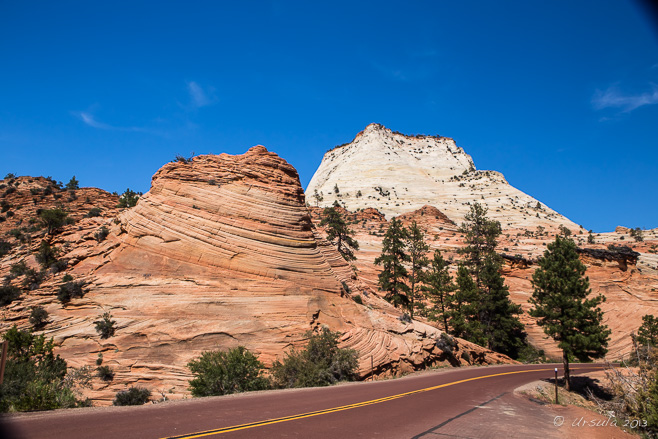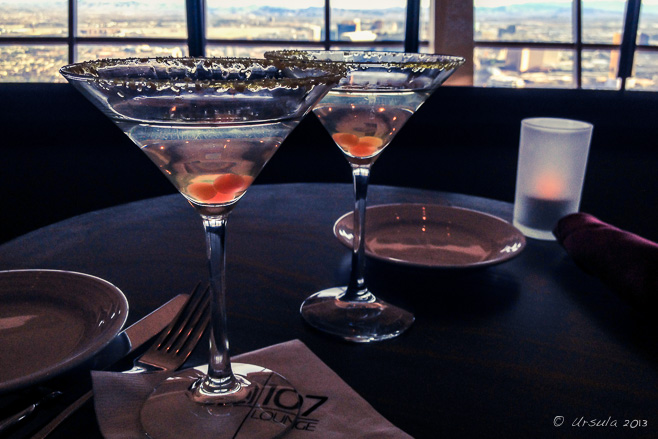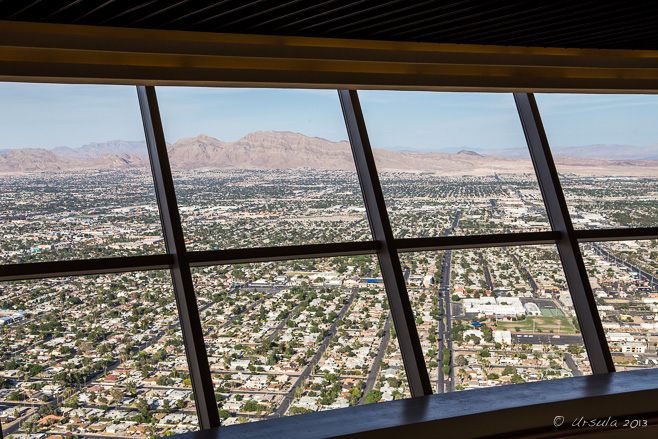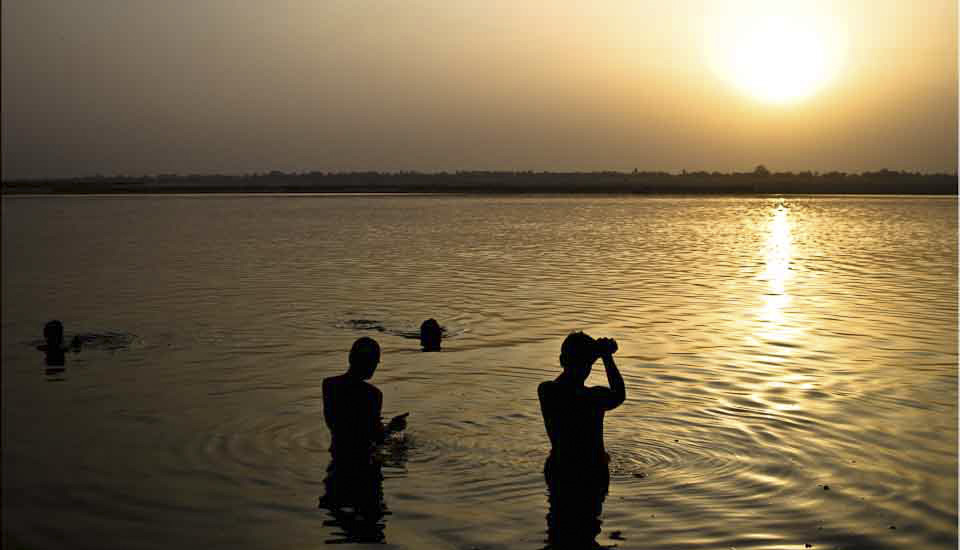 Scenes from a Car Window (US-89 N)
Not far from the bright lights of Las Vegas, there are miles and miles of roads through arid, but stunning, landscapes. One of my Australian friends is heading to the States next month: “Las Vegas!” she told me, with some excitement.
 Drinks over Las Vegas
Vegas is indeed a world apart: a resort city, known for gambling, shopping, drinking, dining and nightlife; …  View from the Stratosphere – 1,149 ft (350.2 m) over Vegas
… an artificially created environment in the middle of the Mojave Desert, surrounded on all sides by mountains.  Vegas Night Lights
The brightest city on earth, as viewed from space (or, in this case, from the Stratosphere), Vegas puts on a glittering display every night. (This is one of those many times I wished I had enough weight allowance to carry my tripod on my travels.) I guess it is an exciting city: there are bars and clubs, live entertainment of every description, and of course the gambling. But, after a day or so, I’m ready to escape. The best part of Vegas, in my mind, is that it is on the way to – or from – somewhere else.
One of those places is the nearby Grand Canyon: still on my bucket list.
But, it is also only two and a half hours of easy driving from Vegas to the magnificent Zion National Park, and then another two hours to Bryce Canyon National Park.
For me, these are much harder to resist than the One Armed Bandits – which are now button operated anyway. We hopped in the car and took highway I-15 N out of the city, out of Nevada, and across the corner of Arizona into Utah.
 Housing on the Outskirts
Utah is one of the less-populous states – especially outside of its city centres. Small settlements dot the intersections of highways, and caravans or mobile homes sit surrounded by farm implements.  View from a Bus
Like most of the National Parks that I have visited in the US, Zion is incredibly accessible. We parked our car and took one of the regular hop-on-hop-off shuttle buses (complete with commentary) that run up and down Zion Canyon Scenic Drive.  Temples and Towers of the Virgin
The shuttle buses stop at popular attractions and at the heads of various walking tracks.  Red Cliffs Rising
The red Navajo sandstone cliffs rise up all around the canyon.  Weeping Rock
It’s a short, easy, walk from the shuttle to one of the park’s more popular spots: the Weeping Rock. Spring waters seep out of the rocks high overhead, raining down on the path below.  Weeping Rock Frame
When you stand under the blind arch, the weeping rock frames the surrounding canyon.  Weeping Rock Greenery
The constant, gentle flow of spring water ensures that the area around the arch is green with life.  Columbine (Aquilegia chrysantha)
Ferns and flowers thrive in the wet, shaded areas.  Scenes from the Roadside (US-89 N)
Rusted “still-life” objects provide visual interest as we continue our drive northeast.  Desert “Garden”
I can’t resist stopping at the patches of prickly pear on the roadside.  Prickly Pear in Flower
The flowers of the prickly pear (Opuntia phaeacantha) are both beautiful …  Prickly Pear (Opuntia phaeacantha)
… and delicate.  Scenes from a Car Window (US-89 N)  Bighorn Sheep (Ovis Canadensis)
Keeping our eyes peeled against the red sandstone …  Bighorn Sheep (Ovis Canadensis)
… we spot a mother bighorn sheep with her young.  Scenes from a Car Window (US-89 N)  Scenes from-a Car Window (US-89 N)
Different coloured buttes have their origins in different geological periods.  Scenes from a Car Window (US-89 N)
The surrounding mountains cast long shadows over the landscape.  Red Canyon (UT-12 E)  Bryce Canyon
The massive walls of Bryce Canyon dwarf the people overlooking the hoodoos on the canyon floor.  Visitors to Bryce Canyon
The light changes rapidly over the massive amphitheater.  Hoodoos on the Canyon Floor
Far below on the canyon floor the colourful pinnacles can be up to 60 metres (200 feet) high.  Pinnacles
The sedimentary rock of Bryce Canyon Amphitheatre was shaped into the delicate-looking hoodoos some 66 million years ago by frost and stream erosion.  Pine Cones  Nightfall (UT-24 E)
As the light falls at the end of the day, we dine on an outdoor table, overlooking more farm machinery and coloured hills. 
Dining al fresco as the sun goes down ~
I much prefer that to the bright lights of Vegas!
Happy Travels
Pictures: 13-14May2013
Posted in America,Landscapes,Nature,TravelTags: America,blog,landscape,National Park,nature,Photo Blog,travel,Travel Blog,Ursula Wall,USA
 Regensburg Streets
Ancient history, charming buildings, and quirky shops attract tourists to the charming little Bavarian city of Regensburg. The cities of Europe – even those which are lesser known to those of us who spend little time there – are fascinating for their charm and their long and rich history.
Regensburg, sitting at the confluence of the Danube, Naab and Regen Rivers, has been the centre of trade, political battle, and religious turmoil since the Stone Age. Located at the northern-most point of the Danube, Regensburg became the site of an important Roman encampment as early as 90AD.
Believed to be the seat of bishops from late Roman times, it is certain that the Bishopric of Regensburg was formally (re-) established in 739. Part of the Duchy of Bavaria from early 6th century and the capitol of Bavaria until the 13th century, Regensburg was also important during the reign of Charlemagne, and had a pivotal role in early Catholicism. Even after the city adopted the Protestant Reformation in 1542, the town remained the seat of a Roman Catholic bishop and several abbeys.
With the building of the Stone Bridge across the Danube in the middle of the 1100’s, Regensburg became a major centre of international trade, the local centre of culture, and renowned for gold work and fine fabrics.
During WWII, the city was home to an oil refinery and a Messerschmitt Bf 109 aircraft factory. In spite of this, strategic bombing on these targets by the Allied Forces left the medieval city centre nearly intact. This left a “notable number of historic structures span[ning] some two millennia and includ[ing] ancient Roman, Romanesque and Gothic buildings”, and resulted in the city’s UNESCO World Heritage Site listing today.
 Tourists on the Canal
Regensburg, one of Europe’s best-preserved medieval cities, is ranked among Germany’s top tourist sights. Today, many international tourists arrive by canal boats and take walking tours through the old town centre.  “Fragments of Memories”
A memorial plaque on the Danube River at Regensburg names the emigrant ships that docked here in the 1700’s.  East Tower of Porta Praetoria
The Romans had their first fort in Regensburg from 90AD. Roman Fort Castra Regina (“Fortress by the River Regen”), originally built in 179, had an entry gate in each wall, with each gate flanked by two massive towers.  Porta Praetoria
In 1885, the remains of the Porta Praetoria, dating back to ancient Roman times, were rediscovered when the Bischofshof Brewery, built on the site some time later, was being renovated.  Roofline
From the cobbles to rooftops, history is in the stones all around.  City-Map Diorama
Gudhorn, a local guide, points out the old-city features to her walking group.  Regensburg Housing
Even the modern housing, on the other side of the river, has charm.  The Alte Würstküche
The “Old Sausage Kitchen” is reputedly Germany’s oldest restaurant: every day, staff in the 900 year-old building make and serve 6,000 sausages – with sauerkraut and mustard – to customers.  Men at Coffee
As is the case across Europe, much business is conducted in the coffee shops, in the streets.  David and Goliath
… past a mural of David and Goliath, originally painted by Melchior Bocksberger in 1573, on a building which stands in the place of an old 12th century inn in the “goliards” – a Goliathhaus: a word which, ironically, has nothing to do – etymologically – with the Goliath story.  Old Regensburg
A walk down Goliathstraße – “Goliath Street” – towards Haidplatz (Meadow or Heath) Square, leads, naturally enough …  Balcony
Everywhere, the old buildings have fresh paint and fresh flowers.  Statue of Don Juan de Austria
Oh, how complicated are the royal houses of Europe! Don Juan de Austria (Don John of Austria), who was born near here in 1547, was the illegitimate son of Holy Roman Emperor Charles V, heir to three of Europe’s leading dynasties and King of Germany, Italy and Spain, with Barbara Blomberg, a young Regensburg woman. Don Juan was well schooled, and was later recognised officially as an heir.  Old-Town Plaza
The plaza around the Old Town Hall is a pleasant place to gather.  Old Town Hall
Parts of the Old Town Hall itself date back to the 14th century.  Bay Window
The window and door details on the Old Town Hall are intricate and beautiful.  Arched Courtyard
Everywhere around the Old Town Hall plaza, there are colourful nooks and crannies.  Dirndles for Sale
Traditional clothing styles are experiencing a revival, and modern shops feature the Bavarian dresses in up-to-date fabrics.  Home of Reformation Discussions
More accidental history: Philipp Melanchthon (Schwartzerdt), follower and friend of Martin Luther, leader of the Lutheran Reformation, held discussions with Dr. Johann Maier von Eck, defender of Roman Catholicism in this house in 1541. The Lutherans (Protestants) won.  Schindler’s House
The city takes pride in the fact that Oskar Schindler, saviour of over 1200 Jews, lived here for a period of time after the war.  Another Clock Tower
More cobbled streets and archways lead to the famous 12th-century stone bridge .  Regensburg Cathedral
The Romanesque Cathedral of St. Peter was originally begun in 1273 and completed in 1525, with ongoing additional touches and restorations through to the 2000s.  “Hutkönig” the Hat King
With an extensive range of men’s and women’s millinery, the “Hutmacher am Dom” got our complete attention for as long as it took to find the perfect style and fit.  “2000 Years”
A modern sculpture incorporating 200 fish – to represent 2000 years of Regensburg history – also marked our return to our boats. Wandering around an old city is a great way to learn some history –

And to acquire a new hat!
Happy Rambles!
Pictures: 18August2014
Posted in Architecture,Germany,History,TravelTags: architecture,bavaria,blog,gremany,history,travel,Travel Blog,UNESCO,Ursula Wall
 Sisterly Care
Young girls smile unselfconsciously for the visitors as they fix each others hair on the front stoop of a blue Jodhpur house. India!
Hot air and warm smiles.
Chaos everywhere: trash and cow pats underfoot, birds overhead, and roadways crowded with pedestrians, cows, cars, and bikes all around.
But it’s the colour that I love…
And the natural grace of the people: everywhere you look there are people, young and old, draped on doorsteps or leaning against walls, their faces open and staring – or smiling – at the visitors, seemingly just waiting to be photographed against the weathered, textured, colourful walls of their cities.
Jodhpur is Rajasthan’s “Blue City”. Houses in the older sections of the city – around the 15th century Mehrangarh Fort – are predominantly painted blue. Most guides will tell you that these houses belong to Brahmins, the “purest” of Indian castes: traditionally the priests and guardians of Hindu religious rituals and spiritual knowledge. Other sources suggest that the blue is more than just indigo tint, but includes the addition of copper sulphate aimed at eradicating termites.
Whatever the reason, the old city’s walls and doors are alive with colour – as I rediscovered on a wander throughout the streets and up to the rooftops of the ancient city with Photographer Karl Grobl and guide DV Singh late on a November afternoon.
 Stand-Off!
Typical Indian chaos: as we try to make our way up the hill to Jodhpur’s Old City, our bus is completely blocked by traffic and roadworks. Smaller vehicles sneak past on either side, leaving us motionless for a very long time. Eventually, our guide got off our bus, engaged in several altercations with other drivers, and eventually guided our driver through the mess. Of course, we’d have to come back the same way later!  Woman in the Street
Meanwhile, people on the street watch on, …  Watchers in the Street
… fascinated by the strangers in the bus.  Corridors and Lane Ways
Finally! Our bus gets us up to the old city, where we wander the streets and lane ways on foot.  Bike and Textures  Woman at the Window
Blues and greens frame the faces of the neighbourhood. Wires hang everywhere.  Kids in the Doorway
A family poses spontaneously at their window: …  Kids in the Doorway
… always ready to smile at the strangers.  Textured Doorway  Rubbish in the Lane Ways  Waving at the Strangers  Boys on the Stoop  Boys at the Doorway  Woman at a Doorway  Old Jodhpur Street  Woman on her Porch  Woman in a Window
As the Autumn sun starts lowering, we are welcomed up to the roof-top of one of the homes.  Mehrangarh Fort
From the roof, we have a view over the blue-painted houses around the Mehrangarh Fort.  Dog on a Wall
Rocky walls, brambles, and piles of rubbish are also on view from our rooftop.  Textured Rooftops  Men on the Rooftop  Man on the Roof  Chai Dishes
We were treated to chai…  Our Chai Wallah
… made for us by the son of a prominent Brahmin: a dedicated engineering student at a local university.  Blue Walls in the Afternoon
In the lowering light, the blue of the walls around us seems deeper.  Chai, chaos and colour… Chai, chaos and colour…
That’s India.
Namaste!
Pictures: 05November2013
Posted in Architecture,India,Portraits,TravelTags: architecture,blog,children,environmental portrait,environmental portraits,India,people,Photo Blog,portrait,portraits,rajasthan,travel,Travel Blog,Ursula Wall
 A Toba Batak Woman How do a people preserve the important values inherent in their culture – more than just a traditional headdress and a signature food – without sacrificing the good things that participating in the modern world can offer?
I often ask myself this when travelling – especially in poorer areas of the world where the people trying to preserve their traditions are not part of the dominant ethnic group.
Samosir Island, a volcanic island in Lake Toba in North Sumatra, Indonesia, is the centre of Batak culture. Descendants of a powerful Proto-Malayan people, the Batak comprise “six (or nine – depending whom you believe) separate groups with different (but related) languages and customs.” The largest of these related groups – and the most culturally distinctive – is the Batak Toba people. Until the arrival of the Dutch in the 1920s, the Toba lived in relative isolation, in the region on and around Lake Toba.
The traditional Batak clan houses, Rumah Bolon, with their elegant saddle-shaped roofs made of thatched sugar palm fibre, are a distinctive sight all around the Batak highlands. Elevated on stilts to protect the occupants against floods or wild animals, these beautiful houses were built without any nails. Some are hundreds of years old. Many are abandoned and falling into complete disrepair. Others have been modified: their old roofs replaced with sheets of corrugated tin. Very few traditional-style houses are being built today – which is why some better-maintained examples of the old styles have been preserved as cultural museums.
The Huta (Village) Bolon Simanindo, once the home of Batak King Raja Sidauruk and his 14 wives, was restored and opened to the public as a museum in 1969. The museum houses a royal boat and a small collection of tapestries, cooking utensils, masks and weaponry.
The real drawcard for tourists, however, is the daily cultural dance performance. While pluralistic religions are not recognised by the state, and most Toba these days are Christian, the dances illustrate some of the old Animist traditions that are still alive and well.
 Graves of the Royal Family
The Bataks have a long, proud tradition. Hulon Bolon Simanindo, or Bolon Simanindo Village, was once the home of Batak King Sidauruk and his 14 wives. The family’s royal tombs sit at the entrance to village, which is now a little museum dedicated to preserving and sharing Toba Batak culture.  Toba Batak Musicians
Toba are said to be capable musicians. Traditional music greets us as we enter the village courtyard in time for the daily dance performance.  Toba Batak Dancers
The “villagers” enter the courtyard, leading a buffalo which plays a key symbolic role in the traditional cultural practices.  Courtyard
Toba Batak houses stand side by side, with their front gables facing the village courtyard or street. The pole the buffalo is tied to is a Borotan, a ritual slaughter pole, decorated with leaves to represent the tree of life: the Banlan.  Toba Batak Man
We have been given notes, telling us what the dancers are doing: …  Hair and Headdress
… mostly, they are offering ritual prayers to the god(s), asking that the buffalo behave well, so that participants will be granted sons, daughters, wealth and health.  Ritual Offerings  Buffalo on the Borotan Slaughter Pole
Once the buffalo is slaughtered, the meat will be shared.  Gondang Siboru
In one number, only the women dance – hoping that one of the men will propose to them.  Young Couple
One couple pairs up and dances together. Of course, it is hard to ignore the fact that most of the dancers are quite old – and probably married already. One has to wonder how well the old traditions will carry forward.  Gondang Pangurason
The spirit of an ancestor comes and possesses one of the dancers…  Blessings
… who then blesses th0se gathered with Holy Water.  Dancing Tourists
The tourists are then loaned festive shoulder cloths (kain pelangi) and invited to dance a few rounds.  Magician
In the Tor Tor Tunggal Panaluan dance …  Magician
… the performer is communicating with the gods, making a specific request for the community.  Sigale Gale
The last dance features a wooden marionette, who in this case represents the dead son of the king. There are several stories about the meaning of these wooden effigies, but the common thread seems to be that it is bad luck to die childless, so a symbolic “child” is needed to avert misfortune.  Toba Batak Woman  Toba Batak Woman  The Royal Boat
The decorations on the boat – as on the buildings – are in the traditional Batak colours of red, signifying zest for life; black symbolising death; and white, representing the holy spirit.  Dancing Masks
In the old days, wooden masks assisted dancers to tell important stories.  King’s Tomb
As we leave the museum, we once again pass the tombs of the king and his family. As ornate as these tombs might seem, they pale in comparison with the many costly and opulent mausoleums all over the island – usually much more lavish than the houses that the living are relegated to! Being seen to honour one’s ancestors is still incredibly important. It was impossible to tell from the dance performance how much of the old traditions are “lived” – rather than just put on display for the tourists. According to Wikipedia, the Toba Batak people maintain distinct aspects of their language and culture, even when they move away from the Toba region.
 They are reputed to be confident and outspoken: characteristics which should stand them in good stead as they move into the future while maintaining some traditions from the past. They are reputed to be confident and outspoken: characteristics which should stand them in good stead as they move into the future while maintaining some traditions from the past.
Till next time!
Photographs: 19February2014
Posted in Culture,Indonesia,Museum,PerformanceTags: animism,animist,architecture,blog,dance,dancer,environmental portrait,environmental portraits,people,Photo Blog,portrait,portraits,travel,Travel Blog,Ursula Wall
 Morning over St Mary’s Asylum
Another English winter day breaks cold and clear as a sun with little warmth rises over the public greens at Burghill. It’s no surprise that every Brit, regardless of age or gender, owns at least one pair of gumboots or wellingtons. You can’t get far in the English countryside without them.
Winter in England has a reputation: grey and bleak and wet.
While it is true that the whole time I’ve been here, it has been wet, at least under-foot (hence the need for rubber boots), everyday has offered at least some sunlight and blue sky. It has been a pleasure walking past the fallow fields on country lanes and roads, past thickets and hedgerows and copses – such British words – alive with the chirping of small birds.
On a recent Sunday walk in Herefordshire, West Midlands, I encountered stretches of ice, puddles of water, expanses of frost, a small patch of snow, and a whole lot of mud. I was thankful for my new rubber boots at every step.
In spite of the vagaries of the terrain – and the dangerous blind corners on roads with no shoulders or verges, bounded by brambles and hedges so there is no escape from the pavement – it was a pleasant walk from my bedsit in one of the renovated buildings around St. Mary’s (Psychiatric) Hospital, Burghill (established as Hereford County and City Lunatic Asylum in 1868) to Credenhill Park Woods, site of a 2000+ year old Iron Age hill fort…
Every little corner of England is layered with history – ancient and modern.
 Morning Frost
There is frost in the hedges and black-ice underfoot: it’s a cold February morning in Hereford.  Snow on the Brecon Beacons
Once out of the St Mary’s housing estate, there are view over Bakers Furlong farmlands and all the way to the mountains of South Wales.  Public Footpath to Burghill?
Footpaths and bridle paths can be found all around the countryside. The trouble is that the signposting leads into unmarked fields, and without a proper ordnance map or local knowledge it is not clear where the path is meant to go and where the gate out of the field might be found.  Burghill Farm
Growing frames wait for the new season.  Fallow Fields
The winter fields are cut down and plowed over.  Herefords
The popular and hardy Hereford beef cattle, now found in over 50 countries, were bred right here in Herefordshire.  Manor House
The hill that comprises Credenhill Park Wood rises up from the surrounding estates and farmlands…  Credenhill Street
… as the road winds around the base into the outskirts of Credenhill village.  “Old Cottage”
This charming English-Heritage Listed timber-framed cottage with a traditional thatched roof was built in the late 17th or early 18th century, with some later modifications.  Snowdrops
Small signs of spring rise up out of the dirt and litter at the side of the road.  Winter Fields
Muddy roads lead off across the fields in all directions.  Horses in the Park
Credenhill Park Wood is a 90-hectare (223-acre) woodland in the Hereford Hills near the village of Credenhill. One of the paths around the ancient semi-natural woodlands is available to specially-licenced horse riders.  Leaf Litter
Steep side-trails that lead between the main trails are muddy and covered in fallen leaves.  Winter Woods
It’s dark in the woods: a thin afternoon sun angles through the thick trees. The park is a mix of native broadleaf trees and non-native conifers that were introduced over the years for commercial purposes.  Fort?
Deep in the woods, there is a fort of some sort in a small clearing.  Open Plateau
Some of the land at the top of the hill has been cleared, allowing 360° views over the countryside. A covered picnic table probably gets more use in warmer weather.  On the Ramparts
The path around the top of the hill fort ramparts may be passable, but it is slippery and rough with tangled roots.  Under the Ancient Yews
The hill fort was built more than 2000 years ago, during the Iron Age. Excavations around the defensive earthworks have given some insight into how it was constructed. An explanatory signboard sits under the branches of a three-hundred year old yew tree.  Stairs
Steep stairs lead up and down the ancient ramparts, which still rise to over 10 metres high in places.  Holly  Ivy  Into the Woods
The woods are a dense mix of broadleaf trees (beech, ash, and hazel) and non-native conifers.  Livestock Enclosure
Part of the hill is fenced off for stock grazing.  Wild Clematis
Back on the roadway outside the woodlands, wild clematis winds around the winter hedges along the roadside…  Tree on the Road
… and trees without leaves stand tall against the afternoon sky. There is life in the English winter woods: I saw plenty of birdlife, including three pheasants that whooshed over my head when I startled them. Squirrels and rabbits are never far away.
It’s a lovely place for walks – as long as you dress warmly, and pack an umbrella just in case…
 – and wear your rubber boots. – and wear your rubber boots.
Till next time ~
Happy Rambles!
Pictures: 08February2015
Posted in Great Britain,Landscapes,Nature,TravelTags: blog,history,landscape,rural,travel,Travel Blog,Ursula Wall,walk,woods
« Older posts
Newer posts »
|

































































































 Chai, chaos and colour…
Chai, chaos and colour…



























 They are reputed to be confident and outspoken: characteristics which should stand them in good stead as they move into the future while maintaining some traditions from the past.
They are reputed to be confident and outspoken: characteristics which should stand them in good stead as they move into the future while maintaining some traditions from the past.



















































.png)


I’m back and enjoyed all you’ve placed on your blog during my absence. Nice different series. I wish you a nice day Ursula. Warm greetings Dietmut
Nice to have you back, Dietmut!
Enjoy your spring. 😀